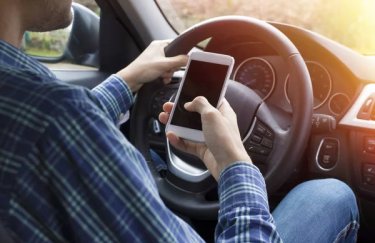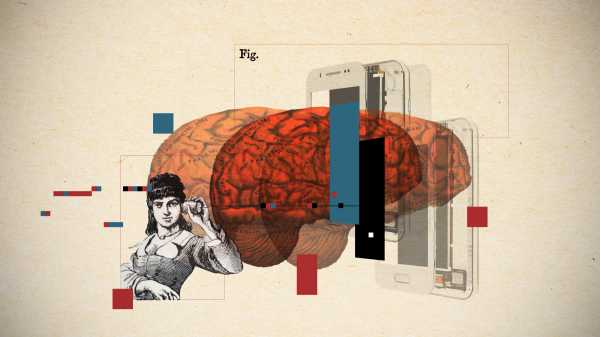
Have smartphones really destroyed a generation? We don’t know.
But here’s how to find out: Scientists need to ask better questions — and big tech needs to help.
By
Brian Resnick@B_resnick
Updated
Feb 21, 2019, 8:49pm EST
Share
Tweet
Share
Share
Have smartphones really destroyed a generation? We don’t know.
tweet
share
Teens in the United States are coming of age at a time when digital technology is truly ubiquitous, where smartphones are all of our “constant companions.”
These youth are also, according to national surveys, increasingly in crisis.
Here are some of the most troubling statistics. Between 2009 and 2017, the number of high schoolers who contemplated suicide increased 25 percent. The number of teens diagnosed with clinical depression grew 37 percent between 2005 and 2014. It could be that more teens are willing to admit they’re struggling and are seeking help. But deaths by suicide among teens have increased as well.
As adults have noticed these trends, they’ve begun to worry: It’s the phones.
“Have Smartphones Destroyed a Generation?” the Atlantic asked in a provocative and widely read 2017 cover story. That article, by San Diego State University psychology professor Jean Twenge, summarized the correlational data linking teen mental health with technology and suggested the answer was yes. There’s also a sense, in the conventional wisdom, that the answer must be yes.
“The effects of technology might be statistically significant but so minimal that they hold little practical value”
Public fears about smartphones aren’t limited to mood disorders like depression, or rates of anxiety. There’s panic about gaming or tech “addiction,” and that we’re losing our ability to focus or remember due to the ubiquity of digital tech. These concerns are easily lumped together into one overarching fear: Tech is messing with our minds.
But take a closer look at the scientific literature, and talk to the researchers who are trying to drill into this issue, and the story grows less certain.
The studies we have so far on the relationship between digital technology use and mental health — for both teens and adults — are more than inconclusive. “The literature is a wreck,” said Anthony Wagner, chair of the department of psychology at Stanford University. “Is there anything that tells us there’s a causal link? That our media use behavior is actually altering our cognition and underlying neurological function or neurobiological processes? The answer is we have no idea. There’s no data.”
Several researchers I spoke to — even those who believe the links between digital technology use and mental health problems are overhyped — all think this is an important question worth studying, and gathering conclusive evidence on.
If technology plays any small part in the rise in teen anxiety, depression, and suicide, we ought to know for sure. And if the ubiquity of digital devices is somehow remolding human psychology — in the ways our brains develop, deal with stress, remember, pay attention, and make decisions — we ought to know that too.
The question of what technology is doing to kids and teens’ mental health is important. The evidence, so far, may not warrant a moral panic. But it does warrant follow-up. So I asked researchers in this field a simple question: How do we get to a more conclusive answer?
They walked me through why this field is so fraught and how it can be corrected. Simply put: Scientists need to be asking better, more specific questions, need to collect better data, and need to do it for all kinds of different mental variables. And surprisingly, they won’t be able to unless technology companies like Apple and Google help them.
Where does the link between teen media use and depression come from?
The hypothesis that frequent technology use and social media are bad for mental health isn’t outrageous.
“The arrival of the smartphone has radically changed every aspect of teenagers’ lives,” Twenge wrote in the Atlantic. Even if you disagree with the word “radically,” it’s hard to deny there has been a change in the ways teens interact (or don’t) with others. Could those changes be related to the troubling uptick in teenage mental health issues?
It’s a fair hunch, a good hypothesis.
First off, when Wagner is saying “there’s no data,” he doesn’t mean there are no studies. He’s saying there’s no causal data — no definitive proof of digital technology altering minds for the worse.
Here’s the state of the field: Large surveys of youth do find negative, statistically significant associations between screen use and certain measures of well-being, including depressive symptoms.
These surveys — like the Centers for Disease Control and Prevention’s Youth Risk Behavior Surveillance System — weren’t designed with the sole intention of studying digital technology use and teen mental well-being. Instead, they’re general assessments of teen behavior and psychology (like drug use, sexual activity, and diet).
In a 2017 study, Twenge and her colleagues found a troubling correlation across a couple of these surveys: Adolescents who spend more time on social media and electronics seemed to be at a higher risk for depressive symptoms and suicide-related outcomes. These effects were largely driven by female adolescents.
Three caveats are worth mentioning right away. One, the data doesn’t imply causality.
Two is that depressive symptoms doesn’t mean a clinical diagnosis of depression. It means the teens agreed with statements like “Life often seems meaningless.” (Though in another similar paper, from a different survey set, Twenge and a colleague found that teens who spend the most time on electronic devices — seven-plus hours a day — were two times more likely to be diagnosed with depression.)
Worried about your teen’s mental well-being? Here are some online resources to learn more about symptoms, treatment strategies, and how to help.
- Effective Child Therapy is a resource from the Society of Clinical Child and Adolescent Psychology. The website has comprehensive information on the emotional concerns, symptoms, and disorders that commonly impact teens (divorce, bullying, body image issues, anxiety, depression, and more) — and the evidence-based therapies that can help.
- The American Academy of Child and Adolescent Psychiatry has information for parents on how to spot symptoms of mental health issues, and where to seek help.
- The Clay Center for Young Healthy Minds has educational articles on mental health issues, as well as many links for where to turn when searching for particular support groups, programs, and therapies.
- The Crisis Text Line is a text messaging-based service for people enduring “any type of crisis.” And the National Suicide Prevention Lifeline is a phone-based service.
Three: “Suicide-related outcomes” does not mean suicide attempts. Instead, they were measuring suicide risk factors. One of the questions used to assess suicidality was, ”During the past 12 months, did you ever feel so sad or hopeless almost every day for two weeks or more in a row that you stopped doing some usual activities?”
Studies like these are rife with such caveats, and more. In general, such studies do not asses causality, they do not include clinical assessments of mental health (just questionnaires), they somewhat arbitrarily define what counts as well-being, they rely on self-reports, and they often use “screen time” or “electronic device use” as a catchall variable to include any type of media use (smartphone, tablet, computer, or otherwise). And the results they find, while statistically significant, are small.
Adding to the noise is the fact that different studies assess different outcomes. Twenge and her colleagues looked at mood; other researchers are more interested in attention, memory, or sleep.
These are just a few of the reasons the research on the big simple question of “is technology good for kids” is so fractured.
To better paint this picture, researchers need to clean up a few huge problems in the literature. Let’s break it down further.
The variable of “screen time” is very hard to measure
You can think of the research on teens, digital technology, and mental health as being like nutrition research, another famously messy field of science.
Nutrition research often relies on reports from people asked to remember what they ate. And people are really, really bad at this — so much so that memory-based diet research may be “fundamentally and fatally flawed,” as my colleague Julia Belluz has explained.
In “nutrition, you wouldn’t talk about ‘food time.’ … You talk about calories, talk about carbohydrates, fats, and proteins’ — the idea of ‘screen time’ contains none of that richness.”
Perhaps we should wonder if the same is true of the research on teens and tech. On these surveys, teens are simply asked to report how many hours a day they spend on computers or smartphones or tablets. And the answers are summed up in a catchall “screen time” metric. Sometimes the question is refined to “how many hours a day do you spend on social media?” Or “how many hours a day do you spend playing video games?”
These questions are hard to answer. How often are you on your smartphone just spending idle time, like waiting to check out at the grocery store, or on the toilet? As media use becomes more mindless, it may become harder to track by self-report alone.
A 2016 study that compared self-reported internet use with actual use found only about a third of people are accurate self-reporters. If anything, people tend to overreport the amount of time they spend online, the study found.
“Screen time” isn’t one single thing — yet it’s often studied as one
Another problem is with the question itself — it’s overly broad.
“Screen time isn’t a thing; it’s 100 things,” Florence Breslin, a scientist with the Laureate Institute for Brain Research, says. “It’s social media, it’s video games. it’s research, it’s reading.” Those categories can even be refined further. Playing an online cooperative game with friends is a different experience than playing a solitary game, for example.
Studies need to better account for the diversity of experiences a person can have with a screen.
In “nutrition, you wouldn’t talk about ‘food time,’” says Andrew Przybylski, an experimental psychologist at the Oxford Internet Institute. “You talk about calories, talk about carbohydrates, fats, and proteins’ — the idea of ‘screen time’ contains none of that richness.”
But it’s difficult because the technology is always changing. Today, teens are on TikTok (whatever the heck that is); tomorrow, they’ll be on an entirely new social media platform. At least in nutrition, a carb is always a carb. It doesn’t get updated like a smartphone app.
“You know how you hear a headline that one week wine is good for you, and the next week it isn’t,” Przybylski outlines. “Imagine if wine changed all the time! Imagine if there was a new kind of wine invented every 48 months.”
Meanwhile, screens are creeping into more places. Heck, you can even buy a refrigerator with a screen connected to the internet. Do those count as “screen time” too?
“Important nuance is missing if we just talk about digital technologies in general,” Amy Orben, a psychologist also with the Oxford Internet Institute, says. “Scrolling through skinny Instagram models will naturally have very different effects than Skyping your grandmother or chatting with your school classmates.”
Scientists want “passive data collection” — and want tech companies to help
Breslin is currently working on an enormous study of adolescent brain development. It’s called the ABCD Study (Adolescent Brain Cognitive Development Study), which is funded by the National Institutes of Health.
The effort is currently tracking more than 11,800 kids for 10 years starting from age 9. The kids are assessed every year on a whole range of developmental and behavioral measures — including physical activity tracking via Fitbits — and every other year, they get a brain scan to track their neurobiological development.
It’s the type of data-intensive, long-term study that’s set up to determine causality. If there are troubling changes in mood, depression, or addiction behaviors in some of the kids, the researchers can analyze what changes and behaviors preceded it. The researchers could, at the end of the study, see what role technology use plays in influencing mental health and brain development during these formative years.
And right now, Breslin admits, it might not be able to provide those answers. They’re limited by the data they can collect.
“Everyone wants a number.” But there’s unlikely to be one-size-fits-all recommendations.
Simply put: “There’s not very good methods for collecting screen time data,” Breslin says, for many of the reasons I mentioned above. The ABCD Study just asks the kids to report what they’re using. The study does break up “screen time” into categories like cooperative video games, solitary games, and social networking. But again, the apps kids are using — and how they use them — are changing all the time. It’s hard to keep up. And therefore, it will be hard for the ABCD Study to make definitive conclusions about the impact screens and social media have on a developing brain.
So instead, Breslin and her colleagues are hoping to add passive data collection. That is, they want Apple and Google — the two main providers of smartphone operating systems — to provide them with data of what the kids are actually doing on their phones.
These companies have this data. Think of the new “screen time” app that was recently added to the iPhone. Weekly, it gives you a recap of how you spent time on your phone. Currently, that data is not available for researchers to use with their participants’ consent.
“Now that screen time is part of the operating system, there’s a lot of push in the research community [for] Apple to allow that data to be a part of its research toolkit,” Breslin says. They hope, with permission from the participants and their parents, to be able to access this data from Apple (Google, she says, is already on board), to figure out how — and, importantly, when — kids are using their phones without having to ask them a single question.
There are third-party apps available to researchers to track phones, but they can be extra invasive, even logging exact keystrokes. They also sometimes crash or don’t interface well with other apps. The benefit of getting the data directly from Apple, she says, is “we’re not producing a piece of data that doesn’t already exist about your child.”
But even with passive data collection, smartphones are just one piece of the total puzzle. And the big question of “is tech bad for teens” will still be hard to answer.
Scientists need to decide what effect sizes matter
Let’s say there is a relationship between digital technology use and mental well-being. How will we know if those relationships are strong enough to matter? This is another critical question the field must answer.
After all, there are endless variables that can come to influence kids’ well-being — their parents, their socioeconomic status, their exposure to environmental toxins, whether they’re read to as kids, and so on.
What if it’s the case that in that mix, digital technology use barely nudges the needle? There might be more powerful interventions — like helping to eliminate childhood poverty — that are more worthy of concern and policy focus.
Here, I think, a visualization is helpful.
The 2017 Twenge study reported that in one of the surveys it analyzed, the correlation between social media use and depressive symptoms was .05. Among girls, the correlation was slightly higher, at .06. Include only boys and the correlation dropped to .01 and was no longer significant.
Correlational relationships, in social science, are scored between negative 1 and 1, with negative 1 meaning there’s a perfect negative correlation (as one variable goes up, the other goes down) and 1 meaning a perfect positive correlation.
So .05 is a pretty small positive correlation. Let’s try to visualize what it means. Psychologist Kristoffer Magnusson offers a cool online tool for visualizing statistics. Here is a hypothetical data plot of 1,000 participants in a study. Imagine the x-axis is symptoms of depression and the y-axis is time spent on social media. If there wasn’t a line drawn through this data, would you see the relationship?
The relationship can also be visualized as a Venn diagram, showing how much overlap exists between the two variables.
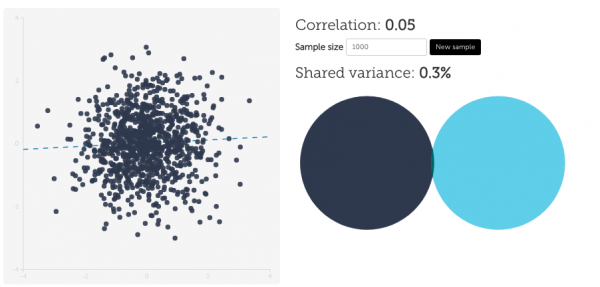
In that study, Twenge and her colleagues also reported that the correlation between electronic device use and suicide-related outcomes (again, as they defined them) was .12, a bit higher. Here’s what that looks like.
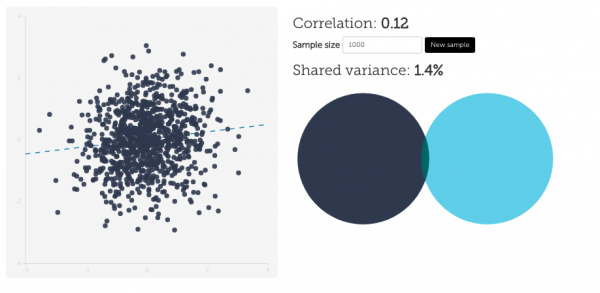
Some of the correlations may be statistically significant and found across many surveys. But are they meaningful?
“We as researchers needs to start thinking not about statistical significance but what is the actual significance of this effect,” Orben says. Recently, she and Przybylski published a paper in Nature Human Behavior, trying to put the correlational research in perspective.
Across data sets with 355,258 participants, they did find a small, negative correlation between digital technology and well-being.
But then they compared that to another childhood milestone that impacts well-being: wearing glasses. And in their analysis, glasses had a stronger negative correlation! Certainly, it’s not fun as a kid to get teased for wearing glasses. But no one is talking about limiting corrective lens use among teens. (Outright bullying, on the other hand, is correlated with a negative impact more than four times that of tech.)
The study also found that “the association of well-being with regularly eating potatoes was nearly as negative as the association with technology use.” Again, there’s no public moral outrage about potatoes, and this is not evidence that kids shouldn’t eat them. “The evidence simultaneously suggests that the effects of technology might be statistically significant but so minimal that they hold little practical value.”
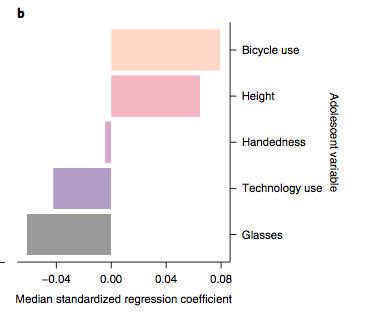
Przybylski and Orben also found that the choices researchers make — on, for instance, how to define depressive symptoms — have powerful influences for the results they find.
“I analyzed all possible paths [through the data],” Orben says, “and I found that you could have written hundreds of thousands of papers that showed a negative correlation between digital technologies and well-being; another couple thousand with non-significant effects, which probably wouldn’t even have been published; and then some with positive. And there, we already see what a mess this is.”
Scientists need to better define, from the start, how to measure the outcomes they care about. Better yet: They ought to preregister their plans of analysis so they can’t cherry-pick positive results later on.
The questions need to become narrower, and more useful. Which means they’ll also be less satisfying to many.
The question of how much screen time is too much, the researchers say, is ultimately too simplistic.
“Everyone wants a number,” Breslin says. But there’s unlikely to be one-size-fits-all recommendations.
With better data, more specific, narrow — and potentially useful — questions about digital technology and mental well-being will emerge.
Here’s one: Do kids who are socially awkward at school benefit from playing with others online? The answer to that question “is not going to tell all of you how many hours of video games you should let your kid play,” Breslin says. “It’s going to tell kids parents of kids who have social issues that this might be a benefit for them.”
Myriad questions will arise: Do disadvantaged kids suffer more or fewer consequences from media use? Is media use a problem, or is multitasking the issue? In what cases are the social connections made on apps beneficial? The questions are endless and complicated. But they are still important, and warrant rigorous study,
“Naturally, we can’t actually do a pure experimental study where some children grow up with social media, some don’t,” Orben says. But at the same time, “life is probably not going to become more offline in the next decade.” If digital technology is harmful to kids, again, we ought to know.
So it’s time to figure out the answers to these questions. “Because, if not, we’re just going to have this debate without any evidence involved,” she says.
Sourse: vox.com


